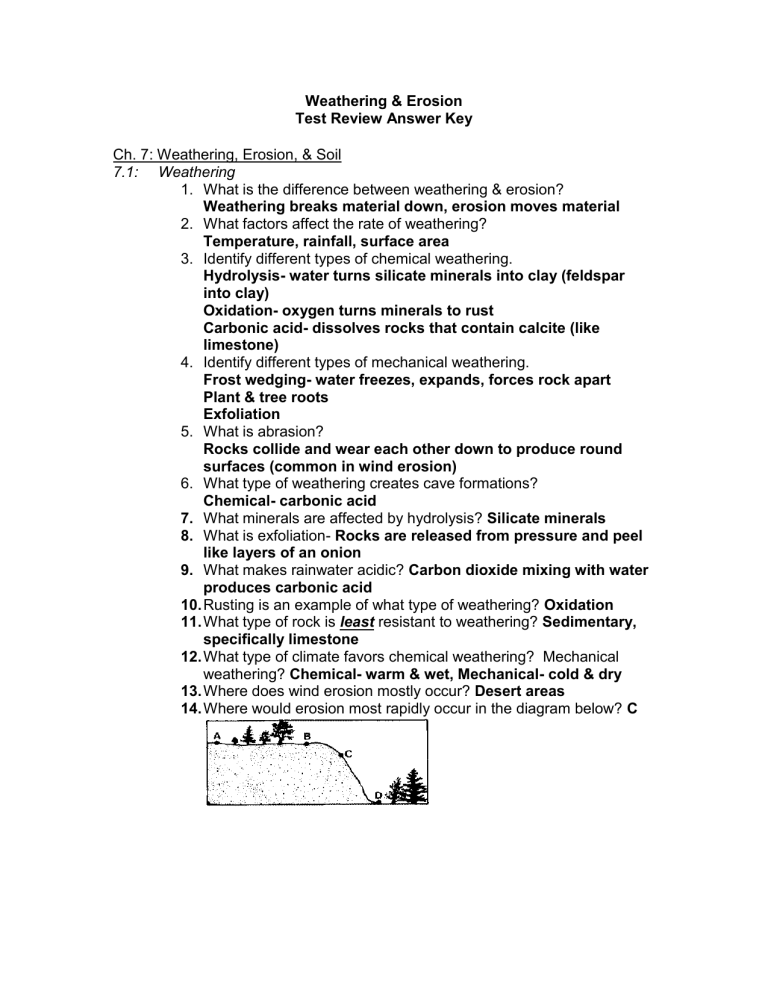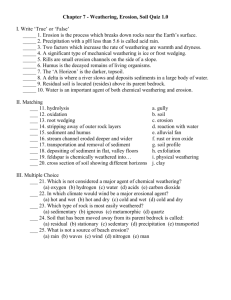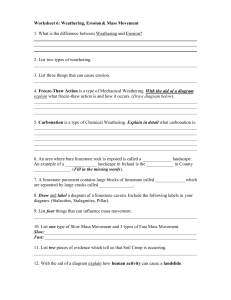Weathering & Erosion

Weathering & Erosion
Test Review Answer Key
Ch. 7: Weathering, Erosion, & Soil
7.1: Weathering
1. What is the difference between weathering & erosion?
Weathering breaks material down, erosion moves material
2. What factors affect the rate of weathering?
Temperature, rainfall, surface area
3. Identify different types of chemical weathering.
Hydrolysis- water turns silicate minerals into clay (feldspar into clay)
Oxidation- oxygen turns minerals to rust
Carbonic acid- dissolves rocks that contain calcite (like limestone)
4. Identify different types of mechanical weathering.
Frost wedging- water freezes, expands, forces rock apart
Plant & tree roots
Exfoliation
5. What is abrasion?
Rocks collide and wear each other down to produce round surfaces (common in wind erosion)
6. What type of weathering creates cave formations?
Chemical- carbonic acid
7. What minerals are affected by hydrolysis? Silicate minerals
8. What is exfoliation- Rocks are released from pressure and peel like layers of an onion
9. What makes rainwater acidic? Carbon dioxide mixing with water produces carbonic acid
10. Rusting is an example of what type of weathering? Oxidation
11. What type of rock is least resistant to weathering? Sedimentary, specifically limestone
12. What type of climate favors chemical weathering? Mechanical weathering? Chemical- warm & wet, Mechanical- cold & dry
13. Where does wind erosion mostly occur? Desert areas
14. Where would erosion most rapidly occur in the diagram below? C
7.2: Erosion & Deposition
1. Describe the relationship between gravity & erosion Gravity pulls materials downward causing erosion to occur more rapidly
2. What happens to a river when it enters a large body of water?
Slows down and deposits sediment
3. What agent of erosion is most powerful Water
4. Where do deltas form? Alluvial fans? Deltas- mouth of a river,
Alluvial fan- base of mountain
7.3: Formation of Soil
1. Describe how soil forms.
Bedrock breaks down, organisms live in cracks, die, decompose, add nutrients to the soil
2. Identify soil characteristics.
3. Recognize soil horizons (see notesheet)
4. What is humus? What is it composed of & where is it found? Rich organic material in soil, found in topsoil (A horizon) composed of decomposed organisms
5. What is the difference between residual and transported soil?
Residual- located above parent bedrock, Transported- located away from parent rock, moved by water or glaciers
Ch. 9: Surface Water
9.1: Surface Water Movement
1. How does surface water move material? See # 6
2. What are some factors that affect whether surface water becomes runoff or seeps into the ground?
Amount of vegetation, slope, soil type
3. What is porosity? Amount of space between particles in a rock or soil
4. What is a watershed? What is the largest watershed in the United
States?
All of the land that drains into a river system, Mississippi
5. What is a divide? Land that separated two watershed
6. How do streams carry their load? (describe three ways)
Solution- dissolved minerals
Suspension- Material held up by water
Bed Load- Drags along bottom, makes river deeper/wider
7. What does carrying capacity refer to and what factors affect a rivers carrying capacity? How much sediment a river can carry, Slope, speed, size
8. What is discharge & what is the formula for it? How much water passes by a given point every second, width x depth x speed
9. How do floodplains develop? When a river rises above the stream banks and overflows it deposits sediment onto the valley floor
10. What are artificial levees used for? Keep water from overflowing, prevent floods
9.2: Stream Development
1. What are some features of young rivers vs. old rivers? Young- fast, narrow, waterfalls, straight. Old- slower, wider, meanders
2. How does a meander form? Where is water fastest in a meander?
Water erodes outside of curve, deposits sediment on inside, fastest water on outside
3. What happens when a meander becomes blocked off? Oxbow lake
4. What term describes all of the sediment carried by a stream or river?
Load
5. When is sediment deposited? When slope changes or water slows down
6. What is base level? The lowest level a river will down cut to
7. What is rejuvenation? How can it occur? When a river begins down cutting again, it occurs if the land is uplifted
9.3: Lakes & Wetlands
1. How do lakes form?
2. What are wetlands
3. What is eutrophication?
Ch. 10: Groundwater
10.1: Movement & Storage of Groundwater
1. How is groundwater stored? Aquifers
2. How does groundwater move?
3. What is the difference between porosity & permeability?
10.2: Groundwater Erosion & Deposition
1. How does groundwater dissolve & deposit rocks & minerals?
2. How do caves form? Acidic water dissolved limestone bedrock
3. What is karst topography & where does it typically occur?
Landscape with lots of sinkholes, occurs where there is limestone bedrock
4. How do sinkholes form? When a cave collapses
5.
What’s the difference between a stalagmite & a stalactite?
Stalagmite- ground, Stalactite- ceiling
10.3: Groundwater Systems
1. What are some threats to groundwater systems?
2. What is subsidence?
3. What is a spring?







